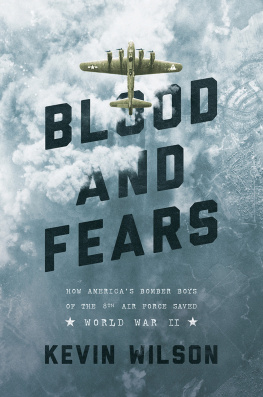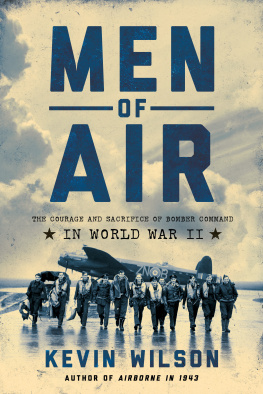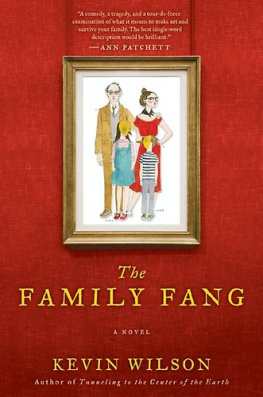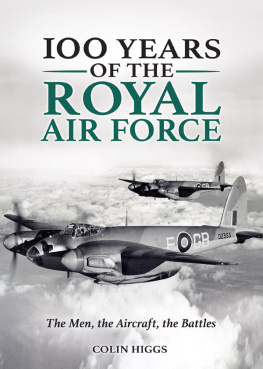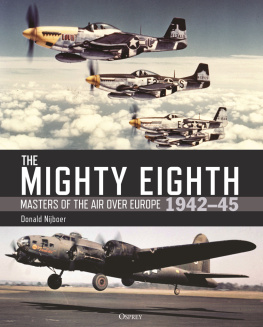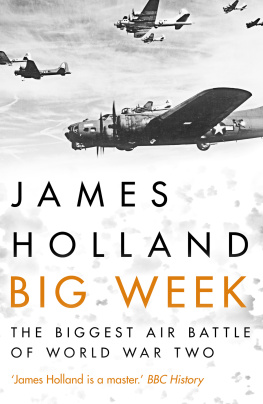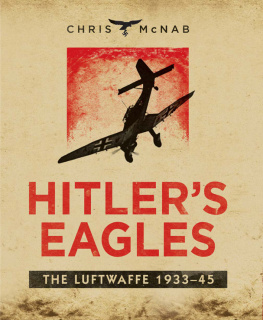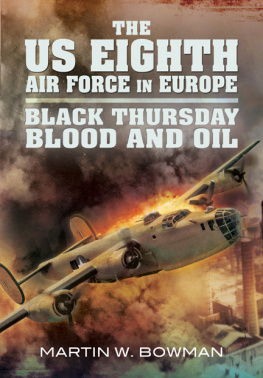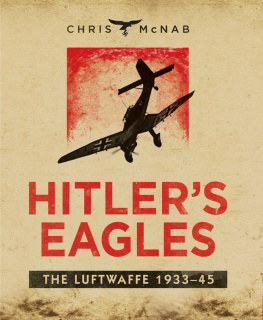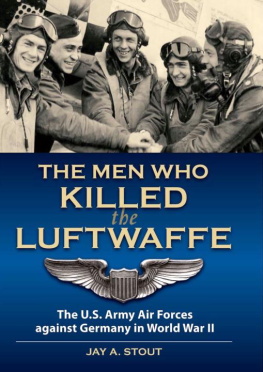
BLOOD
AND FEARS
HOW AMERICAS BOMBER BOYS OF THE
8TH AIR FORCE SAVED WORLD WAR II

KEVIN WILSON

PEGASUS BOOKS
NEW YORK LONDON
To Macy and Austin,
who bring joy to our hearts
The young crews of the United States Army Air Force who arrived in Britain with bright and boundless optimism in the opening months of 1944 to finally put paid to Hitler, stepped down from their Flying Fortress and Liberator bombers into an atmosphere guaranteed to dampen the enthusiasm of the most hopeful heart. England and in fact the whole of Europe was gripped in the rigours of the worst winter for nearly thirty years. The airmens months of training in the New Worlds sunshine states had left them ill prepared for it.
As they groped through the blackout to their temporary billets there was the first intimation of a climate of fear. The excitement of arriving in the old world where centuries-old customs still held was quickly dissipated by the chilling cold of Quonset huts at holding bases before assignment, buildings of iron where the rumours echoed and the tabulations of chance were added up and taken away again. In the autumn, only weeks previously, sixty of the 320 US bombers which had set out to bomb the ball-bearing factories of Schweinfurt had not returned and another 120 were so badly damaged they were off the flight roster. It was the second time it had happened in short order, a similar toll being exacted in a Schweinfurt-Regensburg mission in August. US 8th Air Force (8th AF) operations had been virtually halted and Congressmen had debated whether to end altogether Americas daylight partnership with Britain in the European bomber offensive.
If the youngsters got off base there was little comfort to be found by wandering into one of the English pubs they had heard so much about. A chance encounter with a fellow airman from the RAF or Dominion air forces would provide no welcoming warmth of comradeship, but more likely a taciturn stiff-upper-lip or a depressing litany of loss. Morale on the RAF bomber stations was at rock bottom as the nocturnal Battle of Berlin cut a swathe through the ranks of the boys in blue.
But in fact the college boys and high school hopefuls from America had arrived at a turning point, the hinge of a beginning, not an end. Within weeks the ebb in the Allied air war would change to flow in a suddenly more positive direction. The influx was here to at last make possible round-the-clock bombing the Americans by day, the British by night, a desire of the Casablanca Directive encapsulated at the 1943 North African conference of the joint US/UK chiefs of staff, but so seldom achieved. Now Americas men and machines would ensure Germans had no rest, just as Britons had little respite in the Luftwaffe city blitz of 194041. The vast resources of the United States, its armaments plants producing a total of 276,000 aircraft in the war, would overwhelm the output of German factories, preparing the way for D-Day. To win the battle of the beaches the Luftwaffe would first have to be defeated in the air and in the factories which kept it alive.
The year that mattered most to the German economy was 1944. After years of under-production as the German people enjoyed the fruits of easy victory Great Britain alone had produced 54 per cent more war planes than the Nazis in 1942 the Reich Armaments Minister Albert Speer had finally rationalised and dispersed manufacturing to achieve a wartime peak of aircraft production in September 1944. But by then it was too late. The worlds great arsenal across the Atlantic had already poured forth an ever-gathering stream of bombers and fighters for the final Gtterdmmerung in the skies above the Reich. The aircrew needed for those planes flew in and came ashore in ever-increasing numbers from the beginning of 1944 to make final victory inevitable.
And while all this was being achieved in the air the American boys created a social change in Britain, often by their sheer volume, which would build to a sociological revolution. They were an incomparable force of nature. One in six people in the county of Suffolk, where many of the 8th AF bases were, would be American by 1944. In the tired, war-weary villages of Suffolk, Norfolk, Cambridgeshire and north Essex where lists of sons had been building over four years to join their fathers on war memorials, the arrival of the Americans proved a shock the repercussions of which are still being felt today. Hollywood burst into the hamlet. A succession of film actors arrived to serve or entertain and British civilians and US personnel alike found themselves rubbing shoulders with stardom. It gave glamour to lives already scripted with high drama in which American flyboys had the Aw, shucks charm of screen idols.
The lure of such clean-cut crusaders was not lost on village maidens, who provided solace and comfort to the young men far from home who daily returned from visions of aerial horror no training could prepare them for fearful scenes in which friends were burned alive in stricken bombers or were seen tumbling helplessly to earth without a parachute. In fact the promise of such a warm, female welcome had even been alluded to in official USAAF training material. A movie star turned airman-documentary maker had turned to the camera, pointed to his pilots wings and said the glittering badges effect on girls was phenomenal. That desire to cut a dashing figure when the draft came had proved a bigger draw than the words of any recruiting poster.
But there were other more serious reasons for choosing to join the air war, rather than slog through mud in the infantry or face endless stretches of ocean in the navy. In the immediate previous decades of peace the youngsters of the United States had become more air-minded perhaps than any other nation as the new travel medium shrank its vast continent. Now American boys were getting the chance to turn remote hope into reality by learning to fly at the governments expense. Seldom expressed, but buried in the psyche was also the greater knowledge that the Nazis were enslaving the old world across the Atlantic a Europe many of the young airmens ancestors came from. Striking from the sky at the heart of the enemy seemed an effective way of breaking those chains.
The training and the clumsy experimentation of the first two years of war were now over. American youth had come en masse to do or die in the skies of Europe. Die they would, 26,000 being killed in the 8th AF. And as suddenly as the Americans had arrived, shaking the foundations of an ancient society, the survivors disappeared back across the Atlantic. They took with them 41,000 British girls and more than 14,000 children they had fathered.
For most combat airmen of the 8th AF the stuff of nightmares they witnessed in the skies over Europe would gradually be swept into the recesses of gentle memory over the following decades. Most of them today would admit their time in the service has a dream-like quality as if it was another young man who had stood in their place and stepped through the fire to glory decades before. But fortunately for the generations that followed, the airmen wrote diaries, a vast number of them, unlike their comrades in the RAF, who in fear of security breaches were not encouraged to do so. And it was not only the men who kept journals. The women who came with them, the WACs and Red Cross girls, created records too, writing home, perhaps more assiduously, about the lost Britain they were enshrining for ever, from the glitz of Yank London to the country kindness of strangers. Not all of the Americans lived to read those scribbled records to their grandchildren. It is the content of these diaries and letters, written within hours of traumatic events in the sky seventy years ago, which is the heart of this book.
Next page
